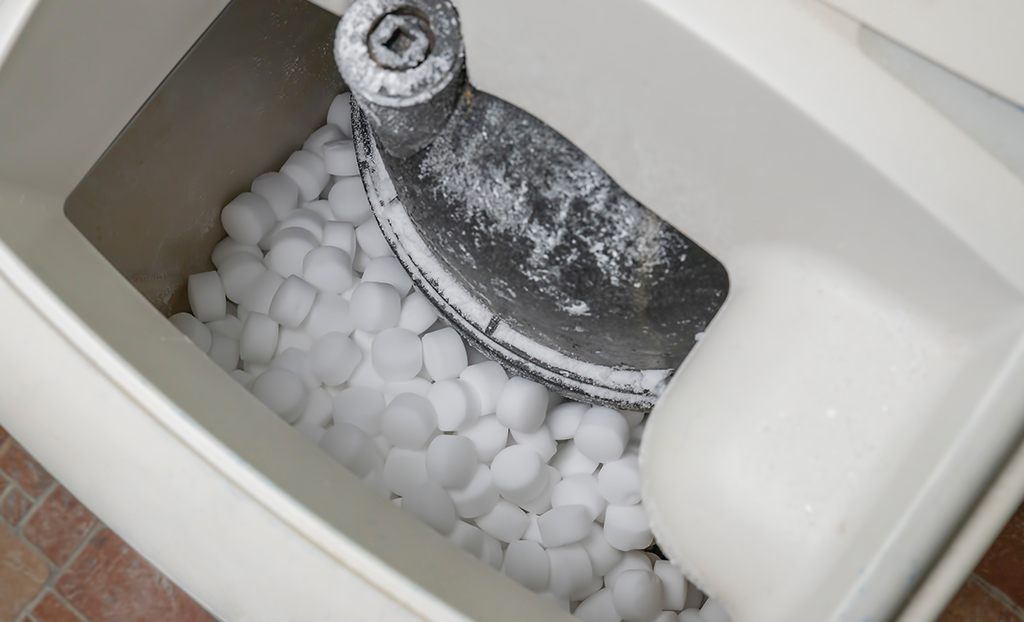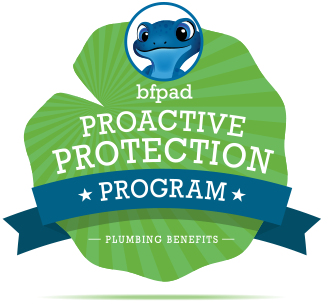
Need A Plumber? Beware Of These Common Water Softener Problems | Schertz, TX
Photo By Denis Klimov 3000 at Shutterstock
The stats are shocking! Approximately 80 percent of US homeowners have to deal with hard water. Knowing that hard water shortens the lifespan of plumbing fixtures, tastes awful, and is detrimental to health, most homes in the United States have plumbers install water softeners. Since groundwater is brimming with impurities, installing home water softeners ensure water is ready for drinking and usable for washing clothes and showering.
Water softeners are vital for the quality of life among Schertz, TX residents because Texas ranks at number six as the state with the hardest water in the United States. Therefore, it will be annoying to encounter softener problems, malfunctioning, breaking down, making funny noises, or misbehaving. Don’t worry! This blog explains common water softener issues.
Water In Salt Tank
If you’ve got a water softener, you may have come across a salt tank that’s full of water. Although this problem could result from many factors, the major culprits could be clogging or lack of airflow in most cases.
Instead of guessing what could be the problem, it would be wise to contact a plumber in Bedford, TX, to troubleshoot the unit and identify the cause. Besides the issues mentioned above, plumbers have noted the reasons listed below for why water could gather in your tank.
- Old Water Softener: Although a water softener can typically last you for about 10 to 15 years, its lifespan may vary depending on factors, such as maintenance, quality, or how it’s used daily. After reaching their lifespan, they degrade quickly, hence you may need a plumber for frequent repairs. In such cases, it is recommended to purchase a new one.
- Broken water entry valve: The function of this valve is to prevent water from entering the salt tank. When it’s damaged, water will flow into the tank, hence it floods. A plumber will replace the lid to fix the issue.
- Setting the float valve at a high level: Sometimes, the problem could be the float valve setup. This valve is designed to control the level of water in the compartment, and if placed too high, you’ll end up with excess water building up, and the softener won’t release it effectively. If you notice the problem is the float valve at a higher position, you can adjust it lower to resolve the issue.
Operation Errors
Another problem with a water softener is operation errors because it depends on manual inputs and settings. Whether big or small, operation errors may end up interfering with the normal functioning of your water softener. Such problems could occur when you are dealing with a new softener or returned to its factory settings due to a power cut.
If your system is particularly complicated and you lack the technical know-how to set it properly, many things will go wrong. For complex water softeners, you can avoid these problems by having a professional plumber in Schertz, TX, help you install and set it up.
Salt Bridges
The primary purpose of water softeners is to prevent minerals from climbing over your pipes, but these systems are still subject to scaling issues. These minerals accumulate, forming salt bridges at the bottom of the tank, preventing your system from softening the water.
Basically, salt bridges are hard crusts of salt that build in the brine tank, and if they are left for long, they could break the system. Detecting salt bridges is not as easy you would think, but you can use a broom handle to poke inside the brine tank to break them gently.
If you notice a salt bridge in the tank, you could break it, but then this is a temporary solution because salt bridges are a recurring problem, mainly when excess salt is used or the wrong salt for the softener set-up and water.
After you’ve fixed salt bridge problems, a plumber will advise you on the types of salt suitable for your softener and the amount you should be using. Also, a clean around the tank edges is recommended to avoid salt bridges.
Plumbers recommend the tips below to avoid recurring salt bridge issues:
- Avoid overfilling the brine tank with salt, especially past the two-thirds mark.
- Always use good quality salt.
- If you have placed the water softener in a basement with high humidity, ensure lower the room’s humidity.
- You can take a wooden broom handle twice per month and poke it into the brine tank through the salt to ensure no salt bridge forms.
Brown Water
Brown water coming out of your tap is not a good site. In most cases, brown water is due to old plumbing, the presence of Tannins in your well-water, or a substantial amount of sediments and dirt in the water feed, hence the last thing to think about is a problematic water softener.
If the problem is with your water softener, then the brown results from manganese and iron build-up in your mineral tank. It would be essential to clean out the system to clear any sediments that have accumulated or rust.
Sometimes, the brown water from the softener could be due to bacteria build-up, making your water undrinkable. You can fix the issue by sanitizing the water softener unit using hydrogen peroxide or chlorine. If, after doing all this, your taps are still streaming brown water, then immediately call a plumber in Schertz, TX, to check the system for any leaks.
Water Softener Doesn’t Use Salt
If you have noticed the salt level in the brine tank is at the same level as the last time you filled it, it means the system is not using salt. This indicates that your softener is pointless because it can’t soften hard water due to a lack of ions exchange.
If your unit is not utilizing salt, it could mean salt bridges preventing salt crystals from dissolving. However, if there are no salt bridges and the unit is not using water, then you can contact a reliable plumber in Schertz, TX, to troubleshoot your water softener.
In such cases, where there are no salt bridges, the problem could be due to a clogging inside the nozzle venturi. For starters, the nozzle venturi draws the brine solution out of the brine tank. When it becomes faulty, the brine solution won’t be removed, hence interfering with salt usage. Qualified plumbers better handle issues with the nozzle venturi.
Resin Beads Problems
Resins are mostly ignored because they function in the background, but when they stop working, they interfere with the normal functioning of your unit.
The water softener tank contains large amounts of tiny beads, commonly referred to as resin beads. These beads remove hard minerals from the water by binding these minerals during the ion exchange process, hence softening the water.
When hard minerals from water come into contact with these beads, they stick to them and are removed from the water that leaves the tank. This process, known as “ion exchange,” makes it possible to have soft water. When these beads collect in the unit’s tank, they are known as the resin bed.
Although resin beads are supposed to last for the entire lifespan of the water softener, some may have to be replaced after every ten years or even less when they break or lose their potential.
When you notice particles are flowing in the softened water, it could mean that the beads are not working correctly. You don’t have to panic because it’s a simple solution that can be easily fixed without spending a fortune or contacting a plumber. Simply replace the resin beads following the instructions outlined in the user manual.
In most cases, the presence of water beads in your water supply could be due to a faulty seal or a damaged seal in the upper distributor. Also, if there is a crack in the upper distributor, water beads will escape into the water supply.
Although some folks may take the DIY approach to fix such malfunctions, it’s advisable to have a trustworthy plumber in Schertz, TX, inspect the upper distributor components and perform the necessary replacements. Finally, you may have to add more resin beads to the filter to replace the lost ones after fixing the upper distributor.
Water Softener Not Softening
After going through the hassle of shopping and installing a water softener, it’s annoying to notice that water coming out of the faucets is still hard. Before searching for a plumber or doing anything, check if the water softener is in bypass mode.
If it is in bypass mode, it could mean the water entering the unit won’t be softened. You don’t need to have necessarily set it on the bypass mode because, at times, the switch could have been knocked into that position or left on after the unit has been cleaned or repaired.
If all is good with the bypass mode, you can check the tank for any presence of debris, scale, or iron buildup. If any, clean and flush the entire system to remove these issues.
The hard water is usually due to salt bridges in the brine tank or resin beads that prevent the softener from producing soft water.
Lastly, if your family size has increased or most members are spending more time indoors, it could mean your system cannot keep up with your family’s water usage, hence the hard water.
But, if your softener has been releasing hard water for some time, it could be that your water is too hard to be fully softened with the current water softener. In that case, it would be best to shop for a more robust water softener.
Water Softener Causing Low Water Pressure
Low water pressure can be frustrating. Although various factors could cause it, in some cases, the primary culprit could be your water softener. To check if the low pressure is due to the water softener, switch on the bypass valve, and if you note the pressure is still low yet there is no water flowing through the softener, then the problem lies elsewhere, and you may need a plumber to conduct inspections. In such cases, the problem could be due to:
- Clogged or corroded pipe at the entry of your home, hence water enters the house before it has been softened.
- A leak in the pipe that connects to the water softener.
- Your provider’s water pressure could be down, mainly if you depend on a municipal or other public water supply.
When the low pressure is coming from the water softener, it could be due to the issues mentioned below:
- The water softener could be small in size: When shopping for a water softener, always consider the size because incorrect sizing of the system could result in low water pressure. For instance, if you go for a unit that has insufficient capacity to keep up with your household’s water usage, you’ll always be having low pressure and other problems. You can consult with a plumber to advise you on the size that would be efficient for your home.
- Sediment build-up: Low water pressure in your unit could be caused by sediment accumulation or clogging. If you think it’s a blockage, you can inspect the entire system, plus the piping, and remove the blockage. Also, ensure the sediment filter is cleaned or replaced frequently to avoid clogging that prevents water flow, causing low pressure.
- Resin clogs: Resin beads washed from the tank could end up clogging the system, resulting in loss of water pressure. You can resolve this problem by replacing resin beads and flushing the system to remove any beads that could still be blocked into it.
- An iron build-up in the resin bed: When iron builds up in the resin tank, it leads to significantly reduced water pressure. To avoid this mess, you can add a mineral cleaner in the resin tank and set more frequent regeneration cycles.
Water Softener Motor Failure
Water softeners need motors to function. Motors use electricity to operate, hence they can fail or even break. If one day you note that your unit has died, it could be due to a motor failure.
But, to be sure, it’s important first to check if the cables are damaged. If the wires are in good condition and the motor still doesn’t start, you can contact the manufacturer for services assistance if the softener is still covered by warranty. But if it is out of warranty, you’ll have to shop for a new motor or a new softener. To avoid motor issues, always have a plumber conduct inspections once in a while.
Your Trusted Plumbers in Schertz, TX
If you are experiencing any softener issues in your home, contact bluefrog Plumbing + Drain of San Antonio for long-lasting repair solutions. We serve areas all over Texas, including cities such as Schertz. Our plumbers can also help with leak detection, plumbing emergencies, drain cleaning, water heaters, and sump pump services. Contact us today!











